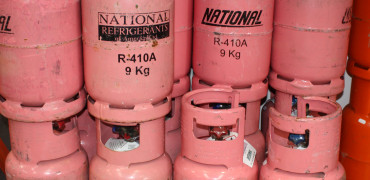You can’t move these days without seeing someone, somewhere making the news about climate change and highlighting the need for us to do something to mitigate our impact on the environment.
Whether it is Sir David Attenborough, or Greta Thunberg, the Extinction Rebellion or the school strikes, the urgent need to tackle climate change is becoming, well, more urgent!
This has led to a growing market for hybrid cars, as a temporary step towards the complete electrification of all vehicles. Temporary until the infrastructure is available to allow all of us to power our cars readily and easily.
But what about our buildings?
There is now a tried and tested solution that is helping building owners future-proof against changing legislation and requirements
An excellent place to start
Buildings account for nearly a fifth of the UK’s greenhouse gas emissions, so finding a way to reduce energy use here would be an excellent place to start to make a difference.
And that is where Hybrid VRF is really starting to impact as more designers and corporate end users come to realise the benefits of this unique system.
VRF stands for Variable Refrigerant Flow and this type of air conditioning has grown in popularity due to its flexibility of design, installation and control, and its ability to take excess heat from one area, and use it elsewhere in the building, thereby saving energy.
These systems use refrigerant (a mixture of gases) which need to be carefully handled and used.
In recent years, the HVAC sector has been desperately searching for ways to increase this energy efficiency further and lower the environmental cost of heating and cooling.
With the development of new F-Gas regulations, older refrigerants like R410A are being phased out and replaced with lower Global Warming Potential (GWP) counterparts, such as R32.
This has now seen the bulk of air conditioning transition from R410A gas, to R32 – except for the larger VRF systems, which are more complex and will not work as efficiently running on R32.
Simultaneous heating and cooling
However, there is now a tried and tested solution that is helping building owners future-proof against changing legislation and requirements, and that is known as Hybrid VRF.
Taking the tried and tested technology behind popular VRF models and adapting to the new demands for lower GWP solutions, Hybrid VRF does not compromise on quality and efficiency.
Still offering the ability for simultaneous heating and cooling in the same way as the traditional VRF, Hybrid VRF operates using water as the heat transfer medium for the majority of the building, rather than refrigerant.
This not only reduces the overall amount of refrigerant being used, the use of R32 significantly reduces the GWP of the system.
Remove leak detection
Another significant benefit is that there is no need to install costly leak detection equipment, which other VRF systems may need, adding to the complexity and time needed for installation and significantly increases the amount of annual maintenance needed.
This is especially needed in occupied spaces, such as hotel rooms or student accommodation and to date, this benefit has resulted in a large number of installations taking place in hotels, where guest comfort is paramount.
At these sites, which often have hundreds of individual rooms, removing the need for leak detection in each occupied space has provided a significant financial benefit, not only on the install savings. In a hotel of 250 bedrooms, there could expect to be a maintenance saving of nearly £100,000 over a 15-year period.
However, it’s not just the hotel industry that benefits from the technology behind the Hybrid VRF. They also offer an ideal solution for applications across a number of other sectors, including hospitals, office buildings and universities. The Hybrid VRF system has the benefit of operating at low noise levels – something which is valuable in any building, as it ensures that occupants are able to sleep, work or study without distraction or disruption.
Hybrid VRF in the medical sector
For hospitals, the health and safety of patients is critically important. In occupied rooms and wards, the absence of refrigerant and the removed need for leak detection is a significant safety benefit and can offer hospitals valuable cost savings.
Ensuring the right temperature in each room is essential to the health of patients and Hybrid VRF systems can deliver greater comfort thanks to the use of water in the indoor units.
This allows for small temperature changes which helps with patient comfort without risking patient safety. The Hybrid VRF system ultimately provides a complete well-being and comfort management solution for staff and patients alike.
Delivering comfort to office workers and students alike
Wellbeing has become an increasingly important factor for modern office buildings and universities. In both, any heating and cooling system must offer the highest level of comfort and freshness for employees and students - and do so as energy efficiently as possible. This makes the Hybrid VRF an ideal solution for these applications.
According to a study conducted on the impact of heat on office productivity[1], employees experience a 2% decrease in productivity for every 1°C above 25° C.
Thermal comfort – a condition of the mind that expresses satisfaction with the environment, i.e. when someone is not feeling either too hot or too cold – becomes vital when you consider the productivity and wellbeing benefits of employees in commercial buildings across the globe.
Ninety percent of business operating costs are staff related, so by improving the overall health of this ‘asset’, you can improve your business.
Multipurpose solutions for multipurpose buildings
In the past, there were very clear lines between what was considered a commercial zone, full of commercial buildings, offices and factories, and what was residential.
Over the years, the boundaries have blurred as an ongoing urban migration has led to people living and working in buildings, particularly in towns and cities, side by side.
Hybrid VRF provides the fully adaptable solution required in these new developments, offering a water source option, which is ideal for environmentally conscious urban sites where outdoor space is likely to be limited, as well as an extensive range of controls to ensure optimum performance for a range of requirements.
Today’s buildings face tough legislation which means that traditional HVAC technologies may no longer be the best solution.
By offering a truly integrated solution that delivers both now and into the future, a Hybrid VRF system can make a real difference.


